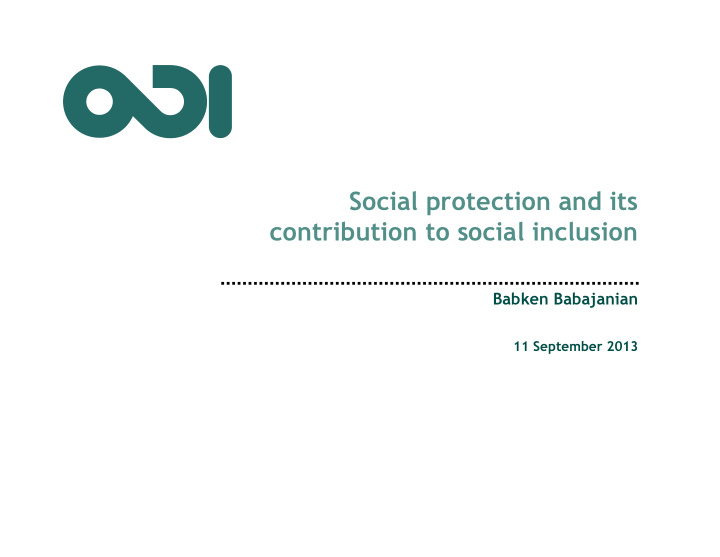



Social protection and its contribution to social inclusion Babken Babajanian 11 September 2013
Social Exclusion framework • Social Exclusion – as a framework/theory/concept vs. descriptive term • Key analytical components: – Dimensions of well-being – i.e., ability to earn income, access services, participate in social and political life and other societal activities – Drivers of poverty and vulnerability that restrict capabilities and opportunities • Allows linking well-being with broader contextual conditions and factors – including institutions, norms and policies 2
Dimensions and drivers of social exclusion 3
The Child Grant in Nepal ODI Research in Karnali – 2012/13 Provides limited income support: • Complements household income • Food, mid-day school meals, school supplies, transportation to health care facilities, clothes for festivals • Limited value - NPR200 (US$2) per month or one eighth of the 2010/2011 poverty line (person/month) • Irregular, partial payments • Lump-sum is more useful for major expenses (e.g. health shocks) 4
Child Grant in Nepal Key drivers of poverty and inequality remain: • Geographic isolation and harsh topography in Karnali • Expensive agricultural inputs • Poor quality of public schools contributes to a dual system - producing inequalities in outcomes • Limited capacity of local health posts generates reliance on private clinics for treatment – contributes to indebtedness and long travel time • Poor local governance – affects Child Grant delivery as well as people’s access to opportunities more generally 5
Addressing drivers of social exclusion • Conditional Cash Transfers seek to address behavioral factors that limit access to education and health/nutrition monitoring and address affordability • Improved school enrolment and attendance; regular health/nutrition monitoring – positive implications for labour market productivity and well-being • Some evidence of improved health outcomes, limited evidence of effects on learning outcomes (e.g. no impact in Brazil) • Some evidence that conditionalities matter, but so does cash support (and perhaps information & outreach) 6
Addressing drivers of social exclusion • Social health protection - addresses obstacles to health care utilisation • Institutionalised inclusive access • Cash transfers improve access/utilisation through income support without altering structural barriers – e.g. user charges, informal fees, etc. • Old-age pensions, disability assistance – addressing old-age vulnerabilities driven by limited ability to take part in the labour market 7
Conclusions • SP can contribute to well-being, without addressing drivers of poverty and vulnerability • SP well-being effects vary depending on design and implementation • Understand combined income effect of social transfers 8
Conclusions • SP can address drivers of poverty and vulnerability • More evidence on long-term SP impacts is required • Need for broader contextual analysis for establishing SP potential to challenge causes of social exclusion • Social protection alone is not enough - need for institutional/policy coordination and integrated approaches 9
Recommend
More recommend